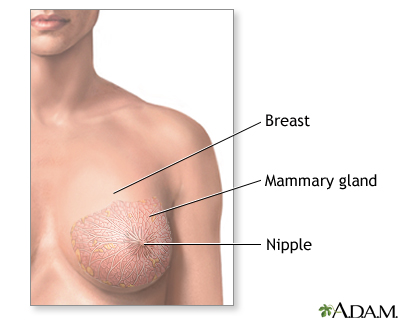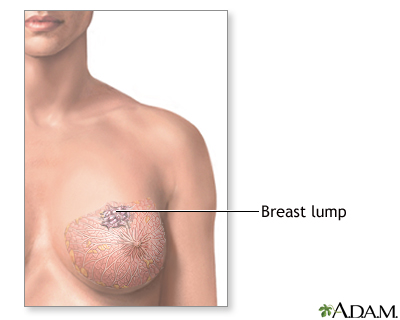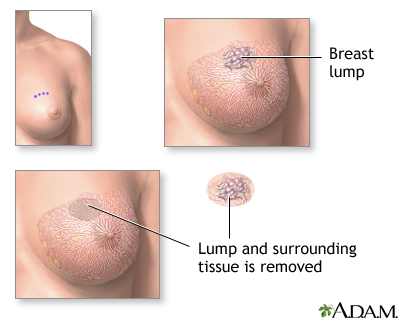Breast lump removal
| Normal anatomy |
The female breast is composed mainly of fatty tissue interspersed with fibrous or connective tissue and milk-producing glandular tissue. The circular region around the nipple is often a different color, or pigmented. This region is called the areola.
|
| Indications |
Early detection of a breast lump is very important to a patient's prognosis (likely outcome). Most breast lumps are not diagnosed at the doctor's office, they are detected by either mammograms or by women themselves. Any breast lump that persists beyond a few days must be reported to a physician.
In some cases, a needle biopsy aspiration of a breast lump can be performed. If the tissue obtained is clearly not cancerous, if no blood was seen on the aspirate, and if the lump disappears after aspiration and does not recur, physicians will often simply observe patients.
Otherwise, the breast lump must be removed surgically to determine if cancer is present.
|
| Procedure |
A breast lump may either be a cyst filled with fluid or a solid mass of tissue. A sample of the breast tissue (biopsy) must be made to determine whether malignant (cancerous) cells are present. Almost two-thirds of all breast lumps are benign, but the chance of a malignant lump is greatly increased if the woman is past menopause.
While the patient is awake and pain-free (using local anesthesia) or asleep and pain-free (using general anesthesia), an incision is made over the lump.
The incision for a lumpectomy is usually around 2 - 3 inches long. The length and position of the incision will depend on the size and position of the lump that needs to be removed. After the lump is removed in one piece, it is sent to the laboratory for examination. If the lump is found to be cancerous nearby lymph nodes may be removed to check for the extent of the cancer spreading.
|
| Aftercare |
The outcome of the lumpectomy depends on the type of lump found. If the lump is benign (whether it is needle aspirated or excised), no further treatment is required.
If the lump is malignant, the outcome depends on the degree to which the tumor has spread. Radiation therapy or chemotherapy may be used in addition to surgery. In certain cases of malignant lumps, lumpectomy followed by radiation therapy is as effective as a radical mastectomy. Typically, lumpectomy does not require a breast reconstruction.
|

|
Review Date:
12/22/2011
Reviewed By:
Harvey Simon, MD, Editor-in-Chief, Associate Professor of Medicine, Harvard Medical School; Physician, Massachusetts General Hospital. |
The information provided herein should not be used during any medical emergency or for the diagnosis or treatment of any medical condition. A licensed medical professional should be consulted for diagnosis and treatment of any and all medical conditions. Links to other sites are provided for information only -- they do not constitute endorsements of those other sites. © 1997-
A.D.A.M., Inc. Any duplication or distribution of the information contained herein is strictly prohibited.






